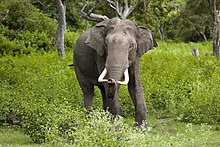| Elephantidae Temporal range:
| |
|---|---|

| |
| A male Asian elephant (Elephas maximus) in the wild at Bandipur National Park in India | |
| Scientific classification | |
| Domain: | Eukaryota |
| Kingdom: | Animalia |
| Phylum: | Chordata |
| Class: | Mammalia |
| Order: | Proboscidea |
| Superfamily: | Elephantoidea |
| Family: | Elephantidae Gray, 1821 |
| Type genus | |
| Elephas | |
| Genera[3] | |
| |
| Synonyms[4] | |
| |
Elephantidae is a family of large, herbivorous proboscidean mammals collectively called elephants and mammoths. These are large terrestrial mammals with a snout modified into a trunk and teeth modified into tusks. Most genera and species in the family are extinct. Only two genera, Loxodonta (African elephants) and Elephas (Asian elephants), are living.
The family was first described by John Edward Gray in 1821,[5] and later assigned to taxonomic ranks within the order Proboscidea. Elephantidae has been revised by various authors to include or exclude other extinct proboscidean genera.
- ^ H. T. Mackaye, M. Brunet, and P. Tassy. 2005. Selenetherium kolleensis nov. gen. nov. sp.: un nouveau Proboscidea (Mammalia) dans le Pliocène tchadien. Geobios 38(6):765-777
- ^ Kalb, J. E.; & Froehlich, D. J. (1995). "Interrelationships of Late Neogene Elephantoids: New evidence from the Middle Awash Valley, Afar, Ethiopia". Geobios. 28 (6): 727–736. Bibcode:1995Geobi..28..727K. doi:10.1016/s0016-6995(95)80068-9.
- ^ Shoshani, J.; Ferretti, M.P.; Lister, A.M.; Agenbroad, L.D.; Saegusa, H.; Mol, D.; Takahashi, K. (2007). "Relationships within the Elephantinae using hyoid characters". Quaternary International. 169–170: 174–185. Bibcode:2007QuInt.169..174S. doi:10.1016/j.quaint.2007.02.003.
- ^ Maglio, Vincent J. (1973). "Origin and Evolution of the Elephantidae". Transactions of the American Philosophical Society. 63 (3): 16. doi:10.2307/1006229. JSTOR 1006229.
- ^ Gray, John Edward (1821). "On the natural arrangement of vertebrose animals". London Medical Repository. 15: 297–310.